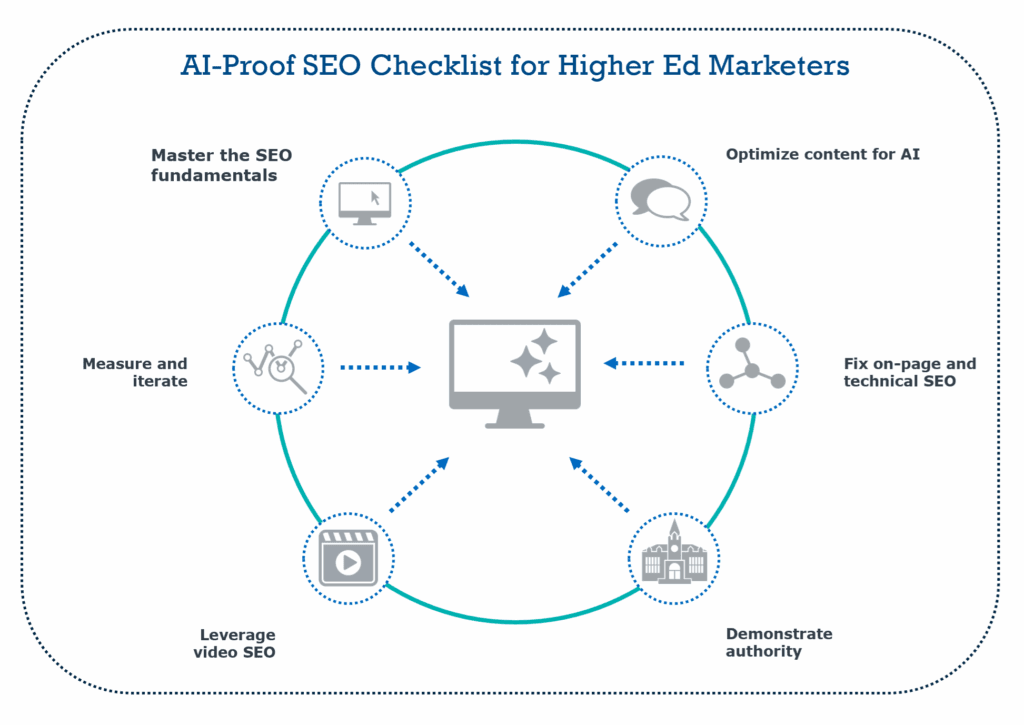The higher ed SEO checklist
The value of your .edu has never been more evident than in today’s AI-driven search environment. But AI has reshaped how people find and trust your content, and higher ed marketing leaders must adapt SEO strategies if they want to stay visible and competitive.
Google’s AI Overviews, the quick-answer boxes that now appear on more than half of informational searches, have led to as much as a 60% decline in click-through rates (CTR), even for top-ranked listings.
To help your institution get ahead of these changes, we’ve created a practical checklist of AI-proof SEO strategies to keep your .edu competitive, trusted, and discoverable in a crowded digital landscape.
Overview of new search terminology
AI has also ushered in new types of search engines to optimize for, including Answer Engine Optimization (AEO) such as Siri or Alexa, and Generative Engine Optimization (GEO), which applies to models like ChatGPT. You’ve likely seen these acronyms everywhere but may still wonder how they differ.
Check out the graphic below for a quick comparison of the “EOs” and their shared priorities. Regardless of the platform, the goal remains the same: help your institution’s content be found, trusted, and chosen.

Key search strategies for higher ed marketing leaders
Use the following checklist to strengthen your institution’s visibility and credibility across traditional and AI-driven search engines.

1. Master the SEO fundamentals
Before diving into AI-focused optimizations, it’s essential to make sure your SEO fundamentals are solid. Strong site structure, clear metadata, and well-targeted keywords lay the groundwork for every other tactic. For a deeper dive into these core principles—from meta tags to long-tail keyword strategy—explore the resources linked below:
Optimize your content strategy for AI
- Adapt to AI summaries: Create comprehensive, in-depth content that adds unique value beyond what’s easily summarized by AI. For example, enhance a standard “How to Apply” page with embedded student testimonials or short video clips that AI can’t replicate in text. Include clear calls to action that encourage users to click through from AI-generated summaries. Strike a balance between writing for humans—clear, concise, and engaging— and providing the depth AI engines look for to recognize authority.
- Optimize for content, not keywords:
- Cluster content: Build topic clusters to help AI understand your site’s hierarchy. For instance, a hub page such as “Understanding Financial Aid Options for Business School” can link to supporting pages on topics like “Business School Fellowships” or “Scholarships for MBA Students.” Each page reinforces the broader theme and improves contextual relevance.
- Target conversational keywords: Use long-tail, question-based phrases that mirror natural searches, such as:
- “best MBA programs with a concentration in sustainable business”
- “how to choose an MBA program for career changes”
2. Fix on-page and technical SEO
- Prioritize mobile-first indexing: Ensure your website is responsive, fast, and intuitive on all devices. 46% of surveyed graduate and adult students primarily visit university websites from mobile devices.
- Enhance page speed: Site performance is both a ranking factor and a user experience driver. Use tools like Google’s PageSpeed Insights to monitor and improve your site’s performance.
- Fix broken links: Regularly check Google Search Console for 404 errors and fix them by using proper 301 redirects.
- Use structured data: Implement schema markup, code that helps search engines interpret your content, so it can be found more accurately in search results and AI answers.
- Optimize for user experience (UX): A seamless experience keeps prospective students exploring your site longer. Clear navigation, intuitive layouts, and prominent CTAs help them find next steps quickly. Together, these elements boost engagement, conversions, and your site’s search performance.
3. Demonstrate authority
- Showcase institutional expertise: Use faculty insights, research, and student stories to publish content that builds topical authority and earns backlinks from credible sources.
- Create authoritative long-form content: Develop guides, program pages, and blog posts that fully answer prospective students’ questions. Focus on clarity, structure, and originality—qualities AI and human readers both value.
4. Leverage video SEO
- Embrace video SEO: Video continues to be one of the most engaging content formats and increasingly appears in AI-powered results. Create student, alumni, and faculty testimonials; “day in the life” videos; or highlight your school’s unique traditions. Video is also a key part of an AI-powered virtual tour experience, giving prospects an authentic feel for your campus and community. Optimize video titles, descriptions, and tags with relevant keywords, and post to channels students use to search for colleges—specifically Instagram, YouTube, and TikTok.
- Make video content accessible: Add transcripts and closed captions to every video. This not only supports accessibility but also gives AI engines more text to crawl, helping match your content to relevant search queries.
5. Measure and iterate
- Use data to improve your site’s visibility: SEO isn’t static, especially in an AI-driven landscape. Track key metrics like organic traffic, keyword rankings, and engagement rates to understand what’s working. Monitor how your content performs in AI Overviews and other answer engines to spot visibility shifts early. Use these insights to refine your content strategy and technical setup regularly.
Maximize your .edu’s recruitment power
AI hasn’t rewritten the SEO playbook — it’s reinforced the fundamentals. Institutions that invest in technically strong sites, optimized content, and clear program pages are the ones showing up where it matters: in AI Overviews, organic rankings, and prospective students’ search results.
The key is focus. Prioritize the high-impact pages that influence inquiries and applications, such as admissions, programs, and cost pages, and make sure they’re built to perform in an AI-driven landscape.
EAB’s Digital Agency partners with colleges and universities to future-proof their .edus with targeted SEO and content strategies that sustain search visibility, credibility, and conversion. Reach out to learn more about our comprehensive search visibility audit and see how your .edu stacks up.
Ready to protect your enrollment with an AI-ready .edu?
Submit the form to speak with an expert.

More Blogs

4 predictions for 2026: What’s next for graduate and online enrollment

What changed in the graduate lead gen landscape in 2025
